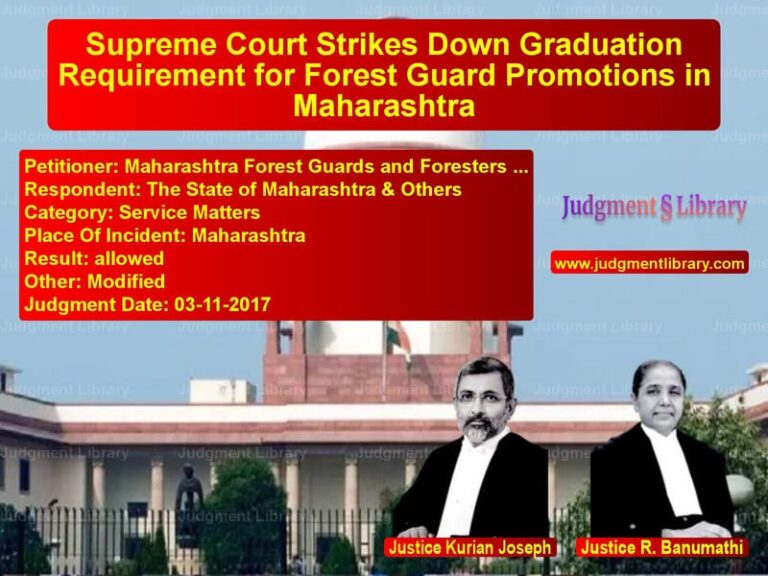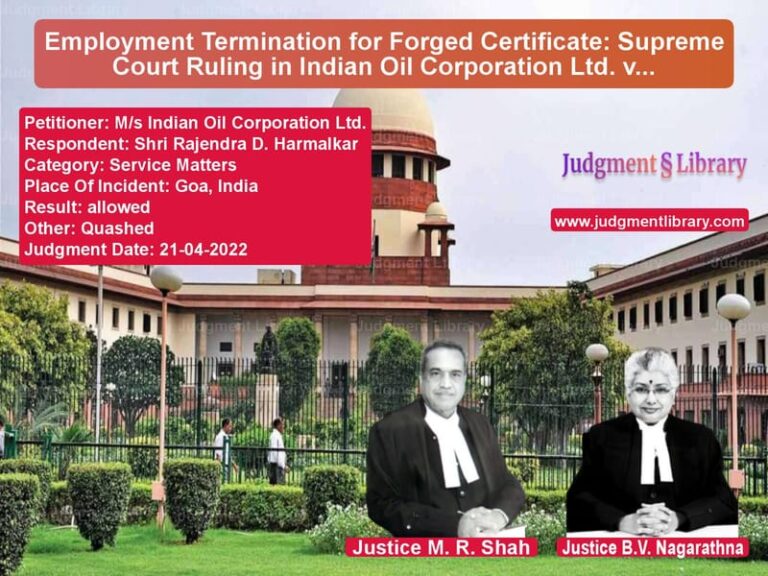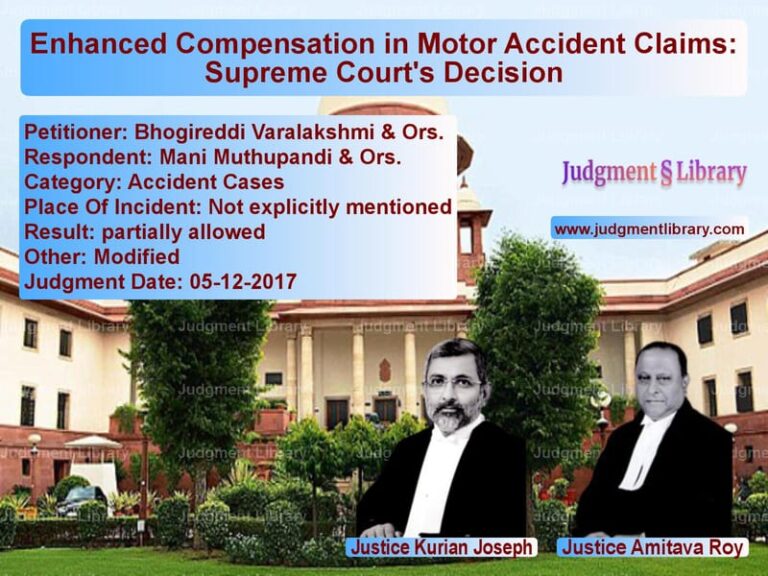Legal Dispute Over Access to Property and Easement Rights: Case of Sulochanabai Swaropchand Chawre
This case involves an appeal by Sulochanabai Swaropchand Chawre, the appellant, against an order passed by the High Court of Bombay, Nagpur Bench, in a matter concerning the access rights to a road from her property. The dispute arose from a decision made by the Additional Commissioner, Amravati Division, Amravati, which directed the creation of a road through the appellant’s property to grant access to an agricultural field owned by respondent No. 4. This case revolves around the issue of whether the respondent has any easement or right to demand access through the appellant’s land.
Background of the Case:
The dispute traces back to an order passed by the Sub-Divisional Officer in Malkapur, which involved a spot inspection of the appellant’s property and the adjacent agricultural land of respondent No. 4. The order directed the creation of a 6-meter wide road marked as ABCD in the map, which would reduce the appellant’s western plot No. 449. This action was necessary to provide access to respondent No. 4’s agricultural field. The appellant contested this decision, leading to an appeal before the Additional Commissioner, Amravati Division, and later a writ petition filed with the High Court of Bombay.
Petitioner’s Argument:
The appellant, Sulochanabai Swaropchand Chawre, argued that the decision to allow respondent No. 4 to access the road through her property was unjustified. The appellant’s counsel contended that there was no easement of necessity or any legal right existing in favor of respondent No. 4. Furthermore, it was pointed out that the permission granted to respondent No. 4 for converting agricultural land to non-agricultural land had already been refused by the Sub-Divisional Officer on the grounds that there was no approach road to the layout proposed by respondent No. 4.
Respondent’s Argument:
On the other hand, respondent No. 4’s counsel argued that access to the road was critical for the agricultural field, which had been restricted due to the lack of proper access. They emphasized that the road through the appellant’s property was essential for the operational efficiency of respondent No. 4’s agricultural activities. Moreover, it was stated that respondent No. 4 had been utilizing this access during the pendency of the appeal, and as such, the status quo should be maintained until the matter was resolved.
Court’s Analysis and Judgment:
The Supreme Court, upon reviewing the arguments and the facts, noted that the High Court had dismissed the writ petition without adequately addressing the core issues raised by the appellant. The High Court’s judgment was found to be overly brief, and the Court emphasized that crucial matters such as the existence of any easement or legal rights for respondent No. 4 were not properly examined. The Court observed that the High Court had failed to provide a thorough analysis of whether respondent No. 4 had a legitimate claim for access through the appellant’s property.
Key Verbal Arguments by the Court:
One of the pivotal verbal arguments by the Court was focused on the failure of the High Court to consider the appellant’s challenge comprehensively. The Court stressed that the questions raised by the appellant regarding the easement rights and the legality of granting access through her land were substantial and deserved a detailed consideration. The Court noted that such issues could not be dismissed without proper examination of legal rights, especially when no explicit easement had been established in favor of respondent No. 4.
Read also: https://judgmentlibrary.com/supreme-court-revises-compensation-in-punjab-land-acquisition-case/
Additionally, the Court pointed out that the appellant had not been given a fair opportunity to present her arguments fully. As such, the matter was remanded for fresh consideration by the High Court, ensuring that all relevant issues would be evaluated properly.
Conclusion:
In conclusion, the Supreme Court allowed the appeal, set aside the High Court’s order, and remanded the case for fresh consideration. The Court ordered the restoration of the writ petition before the High Court, which was to be disposed of within six months. Furthermore, the status quo as of January 11, 2019, was maintained, meaning respondent No. 4 could continue utilizing the road for access, but could not alter the character of the land or use the permission for non-agricultural conversion until the High Court made its final decision. This decision highlights the importance of a detailed and balanced examination of property rights and easements in legal disputes.
Petitioner Name: Sulochanabai Swaropchand Chawre.Respondent Name: The Additional Commissioner, Amravati Division, Amravati & Ors..Judgment By: Justice Uday Umesh Lalit, Justice S. Ravindra Bhat.Place Of Incident: Amravati, Maharashtra.Judgment Date: 20-09-2021.
Don’t miss out on the full details! Download the complete judgment in PDF format below and gain valuable insights instantly!
Download Judgment: sulochanabai-swaropc-vs-the-additional-commi-supreme-court-of-india-judgment-dated-20-09-2021.pdf
Directly Download Judgment: Directly download this Judgment
See all petitions in Contract Disputes
See all petitions in Property Disputes
See all petitions in Landlord-Tenant Disputes
See all petitions in Damages and Compensation
See all petitions in Environmental Cases
See all petitions in Judgment by Uday Umesh Lalit
See all petitions in Judgment by S Ravindra Bhat
See all petitions in allowed
See all petitions in Remanded
See all petitions in supreme court of India judgments September 2021
See all petitions in 2021 judgments
See all posts in Civil Cases Category
See all allowed petitions in Civil Cases Category
See all Dismissed petitions in Civil Cases Category
See all partially allowed petitions in Civil Cases Category







